The team of police officers crisscrosses down a New York City block, bracing for a potential firefight with heavily armed suspects who have taken hostages inside a building.
“We know there are hostages in there,” Lieutenant Kenneth Beatty warns while supervising the operation. “The number’s unknown.”
It’s not real, but it’s not a standard training session, either.
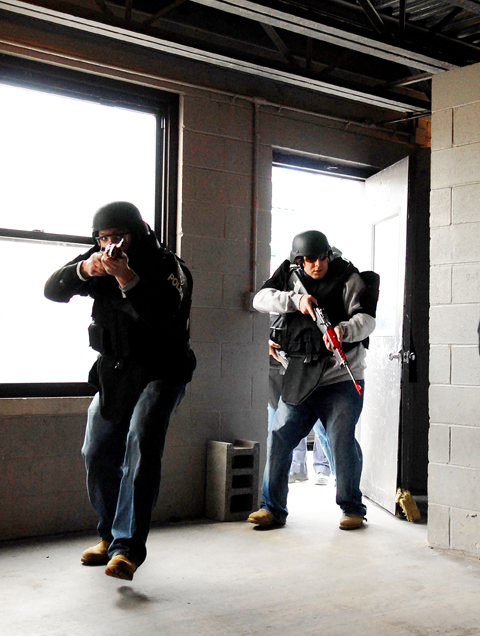
PHOTO: AP
Local authorities believe New York City could be a potential target of militants trained and supplied as well as those who staged coordinated attacks in Mumbai last November, and New York Police Department leaders are determined not to be outgunned.
“Terrorists are thinking creatively about new tactics,” Police Commissioner Raymond Kelly said last week at a City Council public safety hearing. “So must we.”
The largest US police department launched a counterterrorism initiative this month to train a new team of officers with semiautomatic rifles loaded with armor-piercing bullets.
The officers also are being trained in tactics for close quarters combat and rescuing hostages in hotels and other high-rise buildings.
After the three-day assault in Mumbai on luxury hotels, a Jewish center and other sites in November left 164 people dead, the NYPD dispatched investigators to India to see if there were any security lessons for New York. They were struck by how the 10 shooters calmly caused so much mayhem by relying on cellphone communication and Chinese knockoff AK-47s. The local police and security officers, they said, were clearly overwhelmed.
“Their weapons were not sufficiently powerful and they were not trained for that type of conflict,” Kelly said. “It took more than 12 hours for properly armed Indian commandos to arrive.”
The NYPD’s 400 Emergency Service Unit officers already can carry fully automatic Colt M4 rifles — what the manufacturer bills as “the weapon of the 21st century soldier.”
But post-Mumbai, the department decided to train about 130 reinforcements from its Organized Crime Control Bureau with Ruger Mini-14s in case a militant force even larger than the one that struck India’s financial capital invaded here. Police academy recruits will get a tutorial on how to secure assault weapons recovered in combat situations or, in a pinch, how to shoot them.
The NYPD also has begun videotaping the interiors of large hotels so emergency service officers can learn their layouts and match wits with terrorists who, as in Mumbai, may have done surveillance.
In addition, Kelly told the city council that the police want to explore ways to disrupt cell phone service “in a pinpointed way against terrorists who are using them.”
The training session last week took place at the police department’s firearms training facility on a desolate, wind-swept peninsula in the borough of the Bronx.
The street the officers crisscrossed is the NYPD version of a movie studio back lot, with mock street signs, cinderblock storefronts, even a yellow cab and city bus. The guns can’t fire. The hostages are played by other officers.
Instructors drilled officers on how to rescue hostages while giving each other cover.
They warned that terrorists could try to blend in with victims. Any lapse in concentration could prove deadly.
“You guys have to communicate!” one instructor yelled as the officers secured a darkened stairwell as an escape route.
At a nearby firing range, another set of officers used their assault weapons to blast away at targets. They would shoot 600 rounds over two days to complete the training.
Some of the guns were purposely rigged to suddenly fire blanks — a signal to the officers to practice dropping a jammed weapon and immediately draw their semiautomatic pistols and keep shooting.
The exercise was another sign of a new era in policing, said Assistant Chief George Anderson, commanding officer of the police academy.
“We’ve always been prepared to deal with criminals, not terrorists,” Anderson said. “Now we have to go to the next level.”
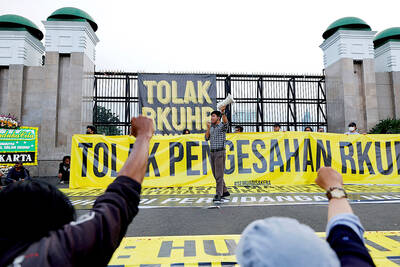
Indonesia yesterday began enforcing its newly ratified penal code, replacing a Dutch-era criminal law that had governed the country for more than 80 years and marking a major shift in its legal landscape. Since proclaiming independence in 1945, the Southeast Asian country had continued to operate under a colonial framework widely criticized as outdated and misaligned with Indonesia’s social values. Efforts to revise the code stalled for decades as lawmakers debated how to balance human rights, religious norms and local traditions in the world’s most populous Muslim-majority nation. The 345-page Indonesian Penal Code, known as the KUHP, was passed in 2022. It
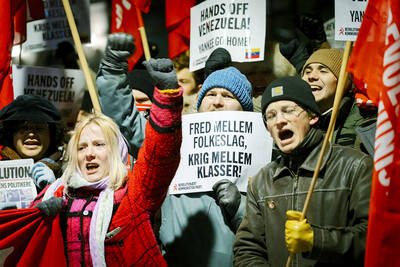
‘DISRESPECTFUL’: Katie Miller, the wife of Trump’s most influential adviser, drew ire by posting an image of Greenland in the colors of the US flag, captioning it ‘SOON’ US President Donald Trump on Sunday doubled down on his claim that Greenland should become part of the US, despite calls by the Danish prime minister to stop “threatening” the territory. Washington’s military intervention in Venezuela has reignited fears for Greenland, which Trump has repeatedly said he wants to annex, given its strategic location in the arctic. While aboard Air Force One en route to Washington, Trump reiterated the goal. “We need Greenland from the standpoint of national security, and Denmark is not going to be able to do it,” he said in response to a reporter’s question. “We’ll worry about Greenland in
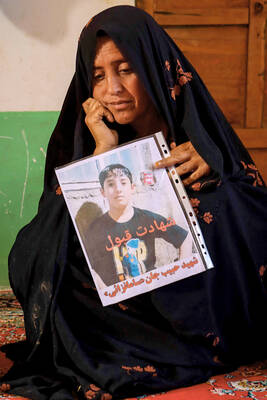
PERILOUS JOURNEY: Over just a matter of days last month, about 1,600 Afghans who were at risk of perishing due to the cold weather were rescued in the mountains Habibullah set off from his home in western Afghanistan determined to find work in Iran, only for the 15-year-old to freeze to death while walking across the mountainous frontier. “He was forced to go, to bring food for the family,” his mother, Mah Jan, said at her mud home in Ghunjan village. “We have no food to eat, we have no clothes to wear. The house in which I live has no electricity, no water. I have no proper window, nothing to burn for heating,” she added, clutching a photograph of her son. Habibullah was one of at least 18 migrants who died
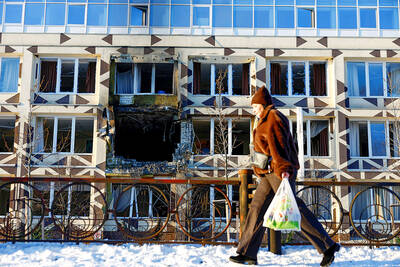
Russia early yesterday bombarded Ukraine, killing two people in the Kyiv region, authorities said on the eve of a diplomatic summit in France. A nationwide siren was issued just after midnight, while Ukraine’s military said air defenses were operating in several places. In the capital, a private medical facility caught fire as a result of the Russian strikes, killing one person and wounding three others, the State Emergency Service of Kyiv said. It released images of rescuers removing people on stretchers from a gutted building. Another pre-dawn attack on the neighboring city of Fastiv killed one man in his 70s, Kyiv Governor Mykola